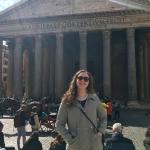Support
When I found out that I would be going to Austria for the semester, I was thrilled. I have been to Europe before as I have spent time visiting my family in the Netherlands and I had the opportunity to participate in the London FYP where I went on a personal trip to the Czech Republic. However, this has been the limit of my experiences. Knowing that Austria is centrally located in Europe, I was excited to explore the surrounding countries and fill my time with satisfying my interests in history. I applied for an innovation grant because I was interested in traveling to Italy specifically, knowing that it was not one of the places my group would travel to on our trips.
Having the experience of seeing historical sites in London and in Austria, I was interested in seeing how different countries and cities have explored preserving history and memory through the reconstruction or lack thereof on specific historic sites.
On my week-long Spring vacation in March, I traveled to Rome where I spent three days, then traveled to Naples and spent three days there. On the first day in Rome I was able to go see the Coliseum, a building which has not been reconstructed to what it originally was, but is still taken care of enough so it is standing. The next day I went to the Vatican city but did not go inside St. Peters Basilica. I also saw the Pantheon, a building which stands as it once was and maintains its memory by its complete reconstruction. In comparison, the Roman Forum was a large area which consisted of ruins. However, the area has been excavated enough for people to see what remains and to carry on the memory of what used to be, by forcing people to use their imagination to see what was there. On the last day in Rome, I went inside of the Vatican to see the art and history which has been preserved exactly and is maintained to keep it safe.
After traveling to Naples I spent a full day traveling to and exploring the city of Pompeii and Mt. Vesuvius. Pompeii was an extremely interesting example of how memory and history are preserved. The majority of the ancient city was preserved naturally by volcanic material, so the history literally just had to be dug up. Unfortunately, the city of Naples itself did not prove to assist in my interests of history.
The things I learned through this project are helping to form my European Studies SYE. In my SYE I will be looking at how different European cities have approached reconstruction of churches and the preservation of memory and history after World War II. I am not using the specific sites that I saw in Italy because I wanted to look at more modern reconstructions and places and churches that went through destruction and deterioration around the same time. After looking at the physical sites, I am now able to look at scholarly research and put together a comprehensive understanding about the preservation of memory in historical sites.
